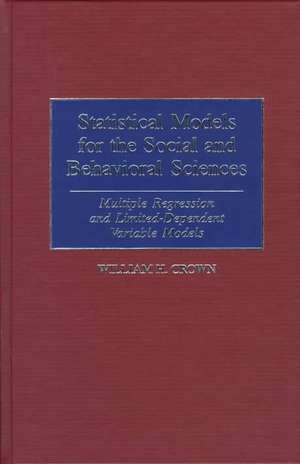Statistical Models for the Social and Behavioral Sciences: Multiple Regression and Limited-Dependent Variable Models
Autor William H. Crownen Limba Engleză Hardback – 17 feb 1998 – vârsta până la 17 ani
Preț: 436.92 lei
Preț vechi: 603.71 lei
-28% Nou
Puncte Express: 655
Preț estimativ în valută:
83.60€ • 87.52$ • 69.18£
83.60€ • 87.52$ • 69.18£
Carte tipărită la comandă
Livrare economică 07-21 aprilie
Preluare comenzi: 021 569.72.76
Specificații
ISBN-13: 9780275953164
ISBN-10: 0275953165
Pagini: 200
Dimensiuni: 156 x 235 x 18 mm
Greutate: 0.47 kg
Editura: Bloomsbury Publishing
Colecția Praeger
Locul publicării:New York, United States
ISBN-10: 0275953165
Pagini: 200
Dimensiuni: 156 x 235 x 18 mm
Greutate: 0.47 kg
Editura: Bloomsbury Publishing
Colecția Praeger
Locul publicării:New York, United States
Notă biografică
WILLIAM H. CROWN is Director of outcomes research at The MEDSTAT Group. Dr. Crown's research focuses on the application of econometric methods to problems in outcomes research, the economics of aging, health policy, and regional economics. He has published numerous articles and is coauthor of State Per-Capita Income Change Since 1950 (Greenwood, 1995) and Economics of Population Aging (Auburn House, 1990), and editor of Handbook on Employment and the Elderly (Greenwood, 1996).
Cuprins
Introduction to Multivariate ModelingInferential Statistics and Measures of AssociationRegression AnalysisNonlinearities and Categorical Explanatory VariablesViolations of Regression AssumptionsLinear Probability, Logit, and Probit ModelsExtensions to the Binary Dependent Variable ModelSummary of MethodsAppendix AAppendix BReferencesIndex













